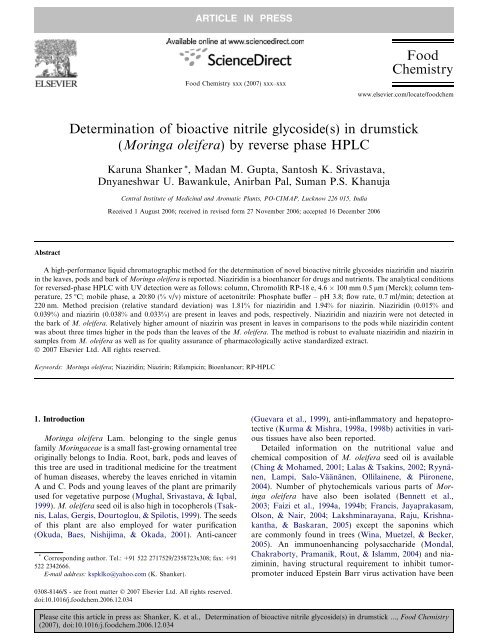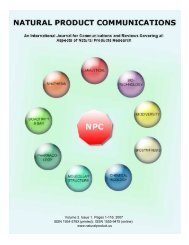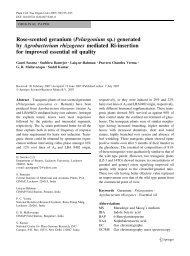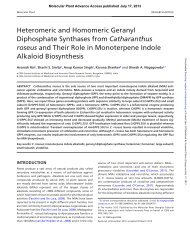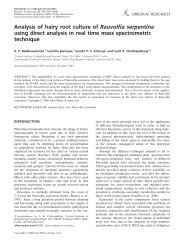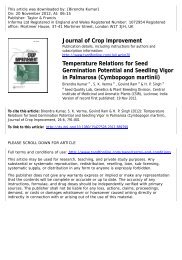Karuna Shanker, Madan M. Gupta, Santosh K ... - CIMAP Staff
Karuna Shanker, Madan M. Gupta, Santosh K ... - CIMAP Staff
Karuna Shanker, Madan M. Gupta, Santosh K ... - CIMAP Staff
Create successful ePaper yourself
Turn your PDF publications into a flip-book with our unique Google optimized e-Paper software.
ARTICLE IN PRESS2 K. <strong>Shanker</strong> et al. / Food Chemistry xxx (2007) xxx–xxxreported from the leaves (Murakami, Kitazono, Jiwajinda,Koshimzu, & Ohigashi, 1998). Recently, a bioenhancingproperty of M. oleifera pods extract was reported andfound that niaziridin rich fraction of M. oleifera podsenhances the bioactivity of commonly used antibiotics suchas rifampicin, tetracycline and ampicillin against gram(+)and ( ) bacteria and also facilitate the absorption of drugs,vitamins and nutrients through the gastro-intestinal membranethus increasing their bio-availability (Khanujaet al., 2005). Therefore, niaziridin can be used in combinationtherapy with drugs and nutrients resulting in reduceddrug associated toxicity, reduced cost and duration ofchemotherapy.In view of the potential bioenhancing properties of thenovel nitrile glycoside niaziridin, optimization of itsextraction and chromatographic conditions for rapidand precise screening of niaziridin and niazirin fromM. oleifera, was performed. Niazirin is another bioactivenitrile glycoside belonging to M. oleifera (Faizi et al.,1994a, 1994b). To the best of our knowledge no validatedHPLC method is available for the quantitative analysis ofboth niaziridin and niazirin in drumstick (M. oleifera).The present method is robust for the quantitative determinationof niaziridin and niazirin in various tissue of drumstick.It can also be used to monitor the batch-to-batchvariation of bioenhancer content in the standardizedextracts of M. oleifera.2. Methodology2.1. Plant materials and chemicalsDrumstick (M. oleifera) leaves, pods and bark were collectedfrom <strong>CIMAP</strong> research field, suburban market ofLucknow. The plant parts were air-dried and ground topowder using a mixer grinder (Philips, India).The solvents used for extraction and chromatographicisolation were of analytical grade. Gradient grade HPLC–UV–Vis quality from Lichrosolv Ò , Merck, India and waterpurified locally on Milli-Q equipment were used. Sodiumdihydrogen phosphate from Merck, India and acetic acidof HPLC quality (Spectrochem, India) and was used forpH adjustment of the eluent.2.2. StandardsReference marker compounds, Niaziridin and Niazirinwere isolated and characterized in our lab. The puritywas determined by HPLC. Spectral details of niaziridinwere confirmed with our patent (Khanuja et al., 2005),while, the authenticity of niazirin was confirmed by thespectral data from the literature (Faizi et al., 1994a,1994b). The stock solutions were prepared in methanol.The chemical structures of bioactive nitrile glycosides ofM. oleifera are depicted in Fig. 1.A. Reference compoundsB. 1. UV Spectra of NiaziridinB. 2. UV Spectra of NiazirinNiaziridin (1)0.30220.50.10220.5AU0.200.00Niazirin (2)0.200.10AU0.00-0.10277.0377.70.00AU-0.10271.0370.5-0.20-0.205.00 10.00MinutesC. Bioactive fraction of pod extractD. Iso-absorbance Map2.00AU1.006 547 8O1CH 2 CN6' 5' 2 3H 3 C 1'4' O OHHO 3' 2'HOHO 6 547 8O1CH 2 CNNiaziridin (1) 6' 5' 2 3H 3 C 1'4' OHO 3' 2'HOHONiazirin (2)350.00nm300.00250.000.0010.00 20.00 30.00Minutes200.0010.00 20.00 30.00MinutesFig. 1. Typical HPLC chromatogram of: (A) standard mixture of (1) niaziridin and (2) niazirin, (B) UV spectra of the respective peaks (C) bioactivefraction of M. oleifera pods analyzed by absorbance at 220 nm. UV pattern of the respective peaks and (D) iso-absorbance map (contour plot) of bioactivepod extract were indicated alongside the chromatogram.Please cite this article in press as: <strong>Shanker</strong>, K. et al., Determination of bioactive nitrile glycoside(s) in drumstick ..., Food Chemistry(2007), doi:10.1016/j.foodchem.2006.12.034
ARTICLE IN PRESSK. <strong>Shanker</strong> et al. / Food Chemistry xxx (2007) xxx–xxx 32.3. Equipment and chromatographic conditionsThe HPLC analysis have been carried out on Watersequipment: pump 600E; auto-injector-717plus; columnoven; detector-996 PDA. Data acquisition and computationwere carried out with Waters Melenium Ò software.Analyses were carried out on Merck Chromolith RP18ecolumn, 5 lm (100 4.6 mm i.d.). Typical chromatogramsare shown in Figs. 1 and 2.All of the standards and extracts were filtered through a0.45 lm syringe membrane filter (Type Millipore) and analyzedby HPLC. Analysis was carried out at 25 °C onaChromolith RP18e (Merck) column. Prior to use, solventswere filtered with 0.45 lm, 50 mm diameter membrane filter(Millipore) and sonicated for 15 min in a Micro clean109 bath (Oscar, India). Chromatography was carriedout using mobile phase of methanol–sodium dihydrogenphosphate–acetic acid buffer (0.1 M, pH 3.8) (20:80) (%v/v). The flow rate during the analysis was 0.7 ml/minand peaks were detected at 220 nm. Although detectionat 275 nm was more selective but detection at 220 nmwas more sensitive and did not pose a problem in termsof co-elution with impurities. Therefore, quantitation ofniaziridin and niazirin was performed at 220 nm peak areadata.2.4. Procedure2.4.1. Extraction of M. oleifera tissuesThe dried powdered leaves, pods and bark (2 g each) ofM. oleifera were extracted with 25 ml of various combinationsof ethanol–aqueous solution (0%, 20%, 40%, 60%,80%, 100%, v/v) by incubation at 30 °C for 24 h. Eachextract was filtered and solvent removed under vacuumat 40 °C. The residue was re-dissolved in 3 ml of HPLCgrade methanol. Niaziridin and niazirin in various extractswere analyzed by an analytical HPLC system. It wasobserved that the extractability of niaziridin was greatlyinfluenced by the ratio of extracting solvent mixtures i.e.ethanol–water. The most effective solvent for the maximumextraction of niaziridin and niazirin was 40% ethanol inwater for pods and 60% ethanol in water for leaves(Fig. 3). Both the markers were not extracted from barksample under experiment conditions studied. Thus weA. Pods (40% ethanol) Extract B. Leaves (60% ethanol) Extract C. Bark (20% ethanol) Extractat 220nm220nm220nm1.50AU 1.000.50Niaziridin (1)Niazirin (2)1.501.00AU0.50Niaziridin (1)Niazirin (2)0.800.60AU0.400.200.0010.00 20.00 30.00Minutes0.0010.00 20.00 30.00Minutes0.0010.00 20.00 30.00Minutes275nm275nm275nm2.00AU1.000.800.60AU0.400.20AU0.100.200.0010.00 20.00 30.00Minutes0.0010.00 20.00 30.00Minutes0.0010.00 20.00 30.00MinutesContour plot of A.Contour plot of B.Contour plot of C.350.00nm 300.00350.00nm300.00350.00nm300.00250.00250.00250.00200.005.00 30.00Minutes200.005.00 30.00Minutes200.005.00 30.00MinutesFig. 2. HPLC profile of: (A) pods, (B) leaves and (C) bark of M. oleifera analyzed by absorbence at 220 nm and 275 nm, contour plot of HPLC pattern of:(A) pods, (B) leaves and (C) bark of M. oleifera UV absorbance at 190–400 nm, respectively.Please cite this article in press as: <strong>Shanker</strong>, K. et al., Determination of bioactive nitrile glycoside(s) in drumstick ..., Food Chemistry(2007), doi:10.1016/j.foodchem.2006.12.034
ARTICLE IN PRESS4 K. <strong>Shanker</strong> et al. / Food Chemistry xxx (2007) xxx–xxx_______Pods______________Leaves_______4035Extractibility (mg/100g)3025201510NiaziridinNiazirin500 40 80 0 40 80Ethanol Composition (%)Fig. 3. Extraction of niaziridin and niazirin with various concentrations of ethanol–aqueous composition for pods and leaves of M. oleifera.selected 40% ethanol–water solution as extracting solventfor pod in our further study. In order to optimize otherextracting conditions, we further carried out an experimenton temperature and time. Extractability (mg/100 g) of niaziridinand niazirin from M. oleifera was observed at40,60,90, and 120 °C for 60,90,120,150, and 180 min,respectively. Result shows that extraction of pods at60 °C for 120 min was the ideal for maximum extractionof 33 mg/100 g and 32 mg/100 g of the target markers i.e.niaziridin and niazirin, respectively.2.4.2. Preparation of standardized extract of M. oleiferapodsEthanol–water extract of M. oleifera pods was lyophilizedand re-dissolved in water and filtered. The insolubleportion was dissolved in methanol. The water soluble portionwas successively extracted with hexane, chloroform,ethyl acetate and n-butanol, respectively. Na 2 SO 4 (anhydrous)was added to each organic fraction for removingthe moisture. All the solvent fractions were concentratedat 40 °C under reduced pressure and tested for bioenhancingactivity of rifampicin. The results indicated that ethylacetate fraction obtained from the crude pod extract possessedthe activity enhancement property. The fractionwith maximum bioenhancing activity was termed as pharmacologicallyactive standardized extract. We further confirmedthat the HPLC method developed by us is able toensure the efficacy and quality of standardized extract.2.5. Statistical analysisData were processed and recorded as means ± standarddeviation of triplicate measurements. Analyses of variance(ANOVA), significance differences between the means andleast square regression (Steele & Torrie, 1980) were performedusing Graph PAD Prism version 3.0 for Windows,GraphPad Software, San Diego, CA.3. Result and discussion3.1. Separation and detection of niaziridin and niazirinSeparation and photodiode array spectrum of (A) standardcompounds niaziridin (1) and niazirin (2) with respectiveUV-spectra, (B) representative HPLC chromatogramsof bioenhancer enriched active fraction of pods with theiriso-absorbance map (contour plot) using ChromolithRP18e column are presented in Figs. 1 and 2 show theHPLC profiles of regenerable tissues, pods, leaves and barkby multiple monitor (220 and 275 nm) and contour plot(190–400 nm) using a photo-diode array detector. The targetedcompounds were not detected in bark sample in studiedcombinations of ethanol–water. The contour plot of theUV absorbance intensity of the compounds shows boththe compounds, which have detectable UV absorbance inthe extracts of various parts of the plant. The presence ofniaziridin and niazirin in various plant parts was confirmedby comparison with the retention time and with the UVspectra matching of the compound in respective extractof the crude drug (Fig. 2).The content (%) of bioenhancer constituent niaziridinand niazirin in various vegetative and regenerable tissuesviz. leaves, pods and bark of drumstick were studied forresearch field station and local market collected samples.Leaves and pod sample of research filed station showedniaziridin (0.015 ± 0.005) and (0.039 ± 0.006), respectivelywhere as niazirin was observed (0.038 ± 0.004) and (0.033 ±0.008), respectively. Market collected sample showed (%)content of (0.010 ± 0.008) and (0.031 ± 0.006) for niaziridinand (0.038 ± 0.010) and (0.029 ± 0.010) for niazirin,respectively. Niaziridin and niazirin were not detected inthe bark samples. Niazirin was present in slightly higheramount in leaves in comparisons to the pods while niaziridincontent was three times higher in the pods than theleaves. The content of niaziridin in market sample wasPlease cite this article in press as: <strong>Shanker</strong>, K. et al., Determination of bioactive nitrile glycoside(s) in drumstick ..., Food Chemistry(2007), doi:10.1016/j.foodchem.2006.12.034
ARTICLE IN PRESSK. <strong>Shanker</strong> et al. / Food Chemistry xxx (2007) xxx–xxx 5lower than the plant samples of research filed station. Thisstresses the importance of chemical analysis in discriminatingthe plant tissues for the isolation of bioactive constituents.From the above results, it is evident that for theisolation of niaziridin, pods of M. oleifera while for niazirinleaves may be used as potential source. Since extracts weremade immediately after drying of the plant material andextracts were stored at 4 °C, decomposition of bioenhancercompounds can be ruled out in the sample.3.2. LC method validationSeveral analytical parameters were evaluated to validatethe new LC method using recommendations defined byICH guidelines for method validation (ICH, 1994, 1996).3.2.1. Calibration graphs, limits of detection/quantification(LOD/LOQ)Standards containing methanolic mixtures of 1 and 2were prepared by dilution using 1 mg/mL stock solution.Five standard of working solutions were prepared by MeOHdilution with concentrations within the expected range ofconcentrations in the material under investigation. The calibrationcurves were determined using the least-squaresmethod, for independent variable (X) the concentration(mg/mL) and for dependent variable (Y) the peak area ofniaziridin and niazirin, respectively was used. Regressionanalyses of both the compounds were performed by GraphPAD Prism 3.0. Linear regression parameters slope =1.99 10 7 and 7.37 10 6 ; Y-intercept = 1.66 10 5 and1.29 10 5 ; X-intercept = 8.37 10 3 and 1.76 10 2 ; S y,xat 95% confidence intervals = 2.09 10 4 and 8.5 10 3 ;correlation coefficient R 2 = 0.9992 and 0.9991 were for niaziridinand niazirin, respectively. The curves confirm the significantlinear relationship between the concentration andthe peak area.LOD and LOQ were determined using the linear regressionequation. Following equations were applied:LOD = 3S y,x /b and LOQ = 10S y,x /b, where S y,x is the standarddeviation of the Y-value distribution around theregression line and b is the slope of the calibration curve.Applying the equations, we determined LODs for niaziridinand niazirin to be 0.003 and 0.004 mg/mL, respectivelyand LOQs were in the same way determined as 0.011 and0.012 mg/mL, respectively.3.2.2. Selectivity/specificityA diode array detector was applied for the selectivitytest. The test was performed on a niaziridin and niazirinin extract of M. oleifera Pods. The test was carried outusing peak purity judgment, which is part of the WatersMillennium Ò HPLC-PDA system for handling 3D chromatographicdata. The principle of peak purity judgmentis to obtain purity angle and purity threshold, of individualpeaks. The reliability of the peak purity test can further beenhanced by carrying out the test at various wavelengths.Typically, when using Waters Millennium Ò PDA software,a component with a peak purity angle lower than its puritythreshold would be considered most likely to be a pure substanceand the separation would be acceptable. Theabsorption spectra of both peaks (1 & 2) were stored inthe software. The peaks associated with niaziridin and niazirinin the extracts were identified by retention times (5.953and 8.085 respectively) and spectra between 200 and400 nm compared with the library of reference compoundsstored in the software. It was shown that in real sampleanalysis i.e. extract of M. oleifera the peak purity angle(niaziridin 0.780 and niazirin 1.981) was lower thanpeak threshold (niaziridin 1.630 and niazirin 2.187).It is evident that at 220 nm, the degree of peak purity ishigher and the absorption spectrum of both compoundswas maximum. Quantitation of compounds both in referenceand sample solution was performed at 220 nm peakarea data acquisition. The selectivity has been shown ona chromatogram for one of the sample of M. oleifera pods(Fig. 1).3.2.3. RecoveryThree different concentrations diluted from the stocksolution were added to an extract with a known contentof niaziridin and niazirin and the recovery of respectiveconstituent was calculated. The recovery (R) was calculatedas R =(C found C sample )/C added , where C found is the concentrationin spiked sample, C sample is the concentrationin the sample prior to spiking and C added is the concentrationof the added standard. Three concentrations of standardcompounds added in the range of 100–120, 180–200and 240–260 lg/mL were used during the study. Theresults of the tests were acceptable, as the average recoveryof niaziridin and niazirin were 86% and 95%, respectively.3.2.4. PrecisionPrecision is a test for the distribution of concentrationsmeasured. Two different concentrations of the stock solutionswere exposed to six determinations on the sameday. Repeatability of analysis was performed in three concentrationrange from 0.4 to 0.9 mg/mL and 0.8–1.8 mg/mL was used during the experiment for niaziridin and niazirin,respectively. All RSD values were below 2%, which isconsidered to be acceptable.3.2.5. Intermediate precisionThis test was carried out using the same equipment ondifferent days for three different samples run in triplicate.All RSD values obtained for both niaziridin and niazirinwere below 5% in the acceptable range of analysis.3.2.6. RobustnessRobustness of the method was tested by varying twoparameters viz. flow rate and column oven temperature.One parameter was kept constant during variation in otherparameter. Different flow rates (0.5,0.7 and 1.0 mL/min)and column oven temperatures (25, 27, and 29 °C) werePlease cite this article in press as: <strong>Shanker</strong>, K. et al., Determination of bioactive nitrile glycoside(s) in drumstick ..., Food Chemistry(2007), doi:10.1016/j.foodchem.2006.12.034
ARTICLE IN PRESS6 K. <strong>Shanker</strong> et al. / Food Chemistry xxx (2007) xxx–xxxused to perform this test. From previous experience it wasknown that the eluent pH should be
ARTICLE IN PRESSK. <strong>Shanker</strong> et al. / Food Chemistry xxx (2007) xxx–xxx 7Murakami, A., Kitazono, Y., Jiwajinda, S., Koshimzu, K., & Ohigashi, H.(1998). Niaziminin, a thiocarbamate from the leaves of Moringaoleifera, holds a strict structural requirement for inhibition of tumorpromoterinduced Epstein Barr virus activation. Planta Medica, 64,319–323.Okuda, T., Baes, A. U., Nishijima, W., & Okada, M. (2001). Isolation andcharacterization of coagulant extracted from Moringa oleifera seed bysalt solution. Water Research, 35, 405–410.Ryynänen, M., Lampi, A. M., Salo-Väänänen, P., Ollilainene, V., &Piironene, V. (2004). A small-scale sample preparation method withHPLC analysis for determination of tocopherols and tocotrienols incereals. Journal of Food Composition and Analysis, 17, 749–765.Steele, R. G. D., & Torrie, J. H. (1980). In Principles and procedures ofstatistics. New York: McGraw-Hill.Tsaknis, J., Lalas, S., Gergis, V., Dourtoglou, V., & Spilotis, V. (1999).Characterisation of Moringa oleifera variety Mbololo seed oil ofKenya. Journal of Agriculture and Food Chemistry, 47, 4495–4499.Wina, E., Muetzel, S., & Becker, K. (2005). The Impact of saponins orsaponin-containing plant materials on ruminant production – aReview. Journal of Agriculture and Food Chemistry, 53(21), 8093–8105.Please cite this article in press as: <strong>Shanker</strong>, K. et al., Determination of bioactive nitrile glycoside(s) in drumstick ..., Food Chemistry(2007), doi:10.1016/j.foodchem.2006.12.034


